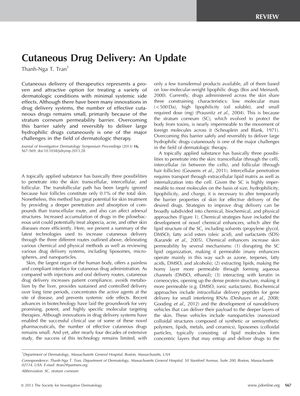TLDR New methods like nanoparticles and microneedles show promise for better skin drug delivery, especially for hair disorders.
The 2013 document reviews the state of cutaneous drug delivery, focusing on the difficulty of passing large hydrophilic drugs through the stratum corneum. It outlines three skin penetration routes: transcellular, intercellular, and follicular, the latter of which is promising for treating alopecia and acne. The paper examines methods to enhance delivery, such as chemical enhancers, peptides, nanovehicles, ultrasound, and microneedles. It highlights the potential of follicular delivery, especially with nanoparticles and microparticles, for increased penetration and sustained release, which could be optimized for hair follicle targeting and effective in treating hair disorders. However, the limited number of effective cutaneous drugs indicates a need for more research to improve large molecule skin delivery. The document underscores the need for technological progress to advance treatments for conditions like alopecia areata.
 55 citations
,
June 2013 in “Dermatologic Surgery”
55 citations
,
June 2013 in “Dermatologic Surgery” Ablative fractional resurfacing could improve how well topical drugs penetrate the skin, but more research is needed to fine-tune the method.
122 citations
,
March 2013 in “Expert opinion on drug delivery” Optimizing drug delivery to hair follicles is crucial for effective treatment.
 97 citations
,
September 2011 in “British Journal of Dermatology”
97 citations
,
September 2011 in “British Journal of Dermatology” The human hair follicle can store topical compounds and be targeted for drug delivery with minimal side effects.
69 citations
,
February 2008 in “The American journal of pathology” Controlled delivery of specific RNA and IL-4 restored hair growth in mice with autoimmune alopecia.
71 citations
,
June 2007 in “Bioorganic & Medicinal Chemistry Letters” PLGA nanospheres improve hair growth by effectively delivering ingredients to hair follicles.
161 citations
,
April 2006 in “Journal of Investigative Dermatology” Liposomes with certain properties can effectively deliver drugs deep into hair follicles.
323 citations
,
April 2006 in “The journal of investigative dermatology/Journal of investigative dermatology” Only 40 nm nanoparticles can enter skin cells effectively for potential vaccine delivery.
 162 citations
,
August 2005 in “The journal of investigative dermatology/Journal of investigative dermatology”
162 citations
,
August 2005 in “The journal of investigative dermatology/Journal of investigative dermatology” The new "differential stripping" method effectively measures how much substance gets into hair follicles.
124 citations
,
April 2000 in “Nature biotechnology”
 2 citations
,
January 2018 in “Elsevier eBooks”
2 citations
,
January 2018 in “Elsevier eBooks” Lipid nanoparticles improve drug delivery through the skin, offering stability, controlled release, and better compatibility with skin.
 13 citations
,
October 2012 in “InTech eBooks”
13 citations
,
October 2012 in “InTech eBooks” Nanocarriers could improve how drugs are delivered through the skin but require more research to overcome challenges and ensure safety.
 94 citations
,
September 2014 in “Therapeutic Delivery”
94 citations
,
September 2014 in “Therapeutic Delivery” Nanoparticles can improve skin treatments by better targeting hair follicles, but more research is needed for advancement.
 3 citations
,
April 2015 in “International research journal of pharmacy”
3 citations
,
April 2015 in “International research journal of pharmacy” Gentamicin penetrates pig skin better through open hair follicles than blocked ones.
 15 citations
,
October 2012 in “InTech eBooks”
15 citations
,
October 2012 in “InTech eBooks” Niosomes are a promising and effective way to deliver drugs through the skin.
 14 citations
,
January 2025 in “AAPS PharmSciTech”
14 citations
,
January 2025 in “AAPS PharmSciTech” Microemulsions and nanoemulsions can effectively deliver drugs through the skin, but more research is needed to understand their differences and mechanisms.










